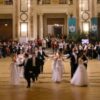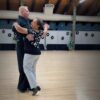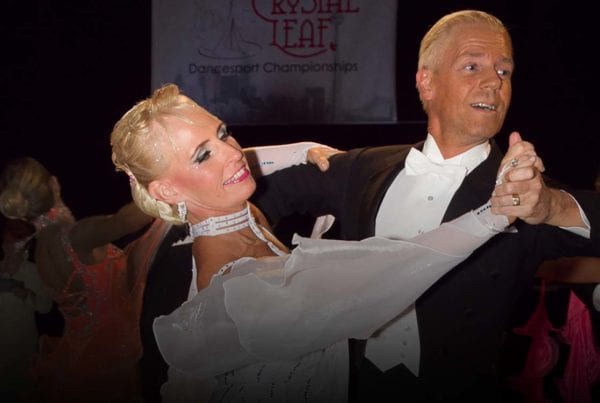The Quickstep is lively, light and a huge amount of fun. Unfortunately, these very qualities have led to an ongoing emphasis over the past few decades on speed and syncopation that have lost one of the best characteristics of this dance. Here’s some insight to help you create a Quickstep that will stand out from the crowd.
The Quickstep was born from the Foxtrot and dates back to the 1920’s. Combining steps from Foxtrot and Charleston and a faster version of the Foxtrot known as Quicktime, it was initially known as the “Charleston Foxtrot and Quicktime” which was ridiculous so the name was shortened to Quickstep. Frank Ford and Molly Spain first performed the Quickstep at the Star Dance Championships in 1927. Even then the dance included its trademark chassés and syncopated steps but left out the Charleston knee actions and high kicks. Victor Silvester, a band leader who was well known in the dance community, wrote, “This dance, when performed well, can be as attractive to watch and as much of a ballroom dance as any we have.” The steps were standardized at London’s Great Conference in 1929 and made a clear distinction from its Foxtrot roots.
Additional light and shade was added to the rhythm of the dance with the influence of Swing music in the 1930s. New steps arrived in the late 1950s when leading couples including Harry Smith-Hampshire and Doreen Casey started adding hops, skips, jumps and the pendulum action to their routine. Together with another British couple, Bill and Bobbie Irvine, and Australians Alf Davies and Julie Reaby, these dancers created something of a stir in the ballroom world as the Quickstep took on a lively personality that simply didn’t exist anywhere else in the formal ballroom world.
However today, Quickstep has degraded so that most of the dance consists of Pepperpots and Scatter Chasses and other syncopated steps, with very little variation in choreography. I’ve even seen couples do nothing but run around the floor for 30 seconds or more. Where’s the dancing in that? So let’s look back at what makes a Quickstep beautiful.
When you study the musical patterns of traditional Quickstep choreography, there are actually more “Slows” than there are “Quicks.” For example, a basic Quickstep routine consisting of Quarter Turn to the Right, Chasse, Forward Lock, Spin Turn, Chasse, Forward Lock, Natural Pivot Turn, Natural Turn, Heel Pull, Double Reverse Spin, Cross Chasse will have 23 Slow movements and only 20 Quick movements. This little detail is lost on too many dancers these days. In an effort to add power and speed to the dance, we are turning all the Slow movements into syncopated steps so that all you have left is Quicks and faster-then-Quick movements.
Don’t misunderstand. I’m not advocating that competitors make slow basic routines. There is nothing wrong with making your Quickstep fast and lively. But a desire to show energy and speed should not sacrifice the beauty of musical contrast. A slow is exactly twice as long as a Quick. When we use the entire 2-beat value of a Slow we can create a beautiful contrast to the Quicks, especially if we also include syncopated steps in our routines.
Quickstep should breathe with joy, power and contrasting speeds. You might have Quick, Quick, Quick-and-Quick, Quick-and-Quick and then add beautiful variety with a sudden group of Slow movements. From there the couple can once again go off to the races with fast, exciting step patterns until they once again slow things down to create dramatic flourish in the choreography. This is especially important for couples in the “Senior” divisions, and even more valuable as the age groups climb. An older couple can look more masterful and in control by showing a mature understanding of musical contrast rather than trying to match crazy athleticism that the young people are doing with their choreography.
I watched a recent competitive event of Senior 3 Championship couples (55+ age group) in which one couple stood out dramatically from all the rest. Most of the couples on the floor were trying to out-perform one another purely on the physical qualities of trying to have the most energetic choreography. The result was that they all pretty much looked the same. They were all doing the usual Pepperpots and Scatter Chasses pretty well everywhere with nothing that drew the eye. But my eyes were drawn to the one couple that was vastly ahead of the pack with musicality that stood out from all the rest. They used the Slow movements to show excellence. Their Quickstep still had energy and still had speed and power, but it also had light and shade that the others were missing. I wasn’t surprised when they won the event. It was the right call in my view.
Take a look at your Quickstep choreography and think about where you might add light and shade with Slow actions so that your entire routine isn’t just frantic racing around the floor. You’ll end up with a distinctive look that stands out from all the rest.
Need evidence? Here’s the most musical couple I’ve ever seen, Luca & Loraine Baricchi, dancing a lovely Quickstep routine full of musical contrast:












